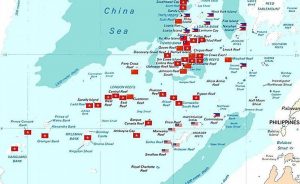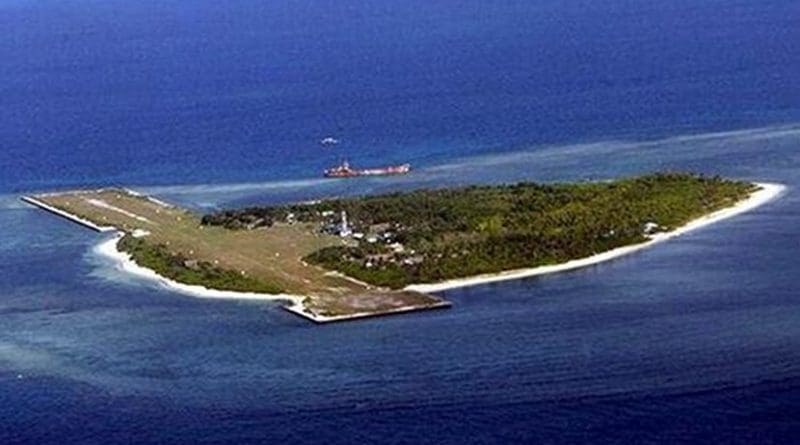Philippines: A Demonstration Of Resolve In Pag-Asa Island – Analysis
By FSI
By Mary Fides A. Quintos*
Following President Duterte’s orders to construct more facilities and rehabilitate its runway, the April 2017 visit of Philippine Defense Secretary Delfin Lorenzana in the Philippine-occupied Pag-Asa Island in the Spratlys marked the start of the government’s preparations for the improvement of the Island. This move is legal, long overdue, and necessary despite any opposition of other parties.
The Philippines’ Pag-Asa Island
Pag-Asa Island is the largest feature in the Spratlys next to Taiwan-occupied Itu Aba. It is the largest of the nine features occupied by the Philippines since the 1970s, and the only one with a civilian population in the area. The Municipal Government of Kalayaan’s official website declares that 12 percent (44, 170.175 square meters) of Pag-Asa Island’s total land area is covered with forest. Its 1.3-kilometer unpaved runway, built in the 1970s, is mostly covered by grass and allows access only to military aircraft and chartered planes from Palawan and Manila. Inclement weather makes the runway effectively unusable; thus causing postponed visits or supply missions to the Island. The Island can be reached through other means of transportation such as a navy vessel or privately chartered vessel, but without a harbor, ships have to dock two kilometers away from the shore. The Island also has a fish handling facility, single telecommunications service provider, municipal health center capable of housing five patients at a time, and transient house for guests of military officials. As indicated in the West Philippine Sea Primer published by the UP Asian Center, other structures in Pag-Asa Island include a weather station built in 1979, lighthouse erected in 1993, town hall, police station, and local election building. The latest improvement in the Island was the installation of water filtration and solar panels in 2004.
The odd man out
Pag-Asa Island is severely underdeveloped compared to the smaller features occupied by other claimant parties in the Spratlys. Malaysian-occupied Swallow Reef, for instance, has been turned into a high-end dive resort with a naval base for security. Many of Vietnam’s occupied features such as Ladd Reef, Pearson Reef, London Reef, and Discovery Great Reef, also have concrete structures, gun emplacements, solar panels and piers, and light posts. Asia Maritime Transparency Initiative reported in May 2016 that Vietnam has reclaimed over 120 acres of land by mostly expanding pre-existing islets in the Spratly Island, Southwest Cay, Sin Cowe Island, and West Reef. It extended its runway in Spratly Island from less than 760 meters to more than one kilometer to accommodate most planes in the Vietnamese air force.
China used to occupy the smallest features in the Spratlys, but its reclamation work on seven reefs has created more than 3,200 acres of new land since 2013. According to Asia Maritime Transparency Initiative, China currently has the most advanced naval, air, radar, and defense facilities in the area. Its runway in Fiery Cross Reef is the longest of any claimants’ in the Spratlys, with the ability to accommodate fighter jets and bomber aircraft. China installed high-frequency radar facilities that bolster its ability to monitor surface and air traffic in the South China Sea. It constructed missile shelters with retractable roofs in Subi, Mischief, and Fiery Cross Reefs, consequently heightening the assumption that China may also deploy HQ-9 surface-to-air missile (SAM) platforms in these features, similar to the Woody Island in Paracels.
Itu Aba hosts facilities that include a hospital, weather station, satellite communication facilities, radar surveillance equipment, five public telephones, and internet connectivity. It has a 1,200-meter long runway that was constructed in 2007. Taiwan completed several development projects in Itu Aba in 2015, among them the construction of two new piers and access roads.
The Philippines’ turn
In contrast to the features occupied by other claimants in the Spratlys, where development and upgrade of structures are continuously being undertaken, the majority of the facilities in Pag-Asa Island have not been refurbished since their construction almost four decades ago. The condition of the runway reflects the urgent need for repairs and improvement of many of these facilities.
The development of Pag-Asa Island is long overdue. Plans for rehabilitation are longstanding but have been repeatedly delayed to avoid contributing further tension to the region amid a series of actions and counter-actions by some parties in the South China Sea dispute to assert their respective claims and enforce jurisdiction. The political reality in the region in the previous years made movement by Philippine forces to any of its occupied features in the Spratlys too dangerous. The Philippines wanted to prevent a situation where untoward encounters at sea among disputing parties could escalate into conflict.

The recent improvement of relations among parties in the South China Sea dispute and the restoration of more friendly and open dialogue at the highest level of government can help avoid misunderstanding on the intention of future actions. It is in the interest of all parties to maintain this positive momentum and continue creating favorable conditions where maritime issues can be dealt with peacefully. Mutual trust, stability, and development remain shared aspirations of all countries in the region.
The Philippine Department of Foreign Affairs stated that any activity in Pag-Asa Island is in fulfillment of the “Constitutional mandate of the government to improve the safety, welfare, livelihood, and personal security of Filipinos in the Palawan Municipality of Kalayaan.” Aside from the improvement and repair of the runway, Defense Secretary Delfin Lorenzana explained that other construction activities planned by the government include barracks for the soldiers deployed at Pag-Asa Island, desalination facilities, sewage disposal system, conventional and renewable power generators, lighthouses, and shelters for fishermen. Improving the transportation and communications system in the Island would allow the government to deliver goods and services more efficiently while building facilities would promote self-sufficiency. These small and necessary improvements are all for civilian and peaceful purposes aimed at providing basic social services, raising the standard of living, and improving the quality of life of Filipino citizens at Pag-Asa Island. It intends neither to provoke conflict nor to diminish the security of the nationals of other claimants stationed in nearby features.
Also, the rehabilitation of Pag-Asa Island will not cause an adverse impact on the marine environment, as it will not involve dredging or reclamation activities. The government will only be building additional structures on top of the preexisting natural feature; it will not create an entirely new land where there used to be none. This move remains consistent with the Philippines’ advocacy to protect the marine environment and preserve its use for future generations.
Residents of Pag-Asa Island have long endured their current living conditions consequential of being in an island remote from the Philippine mainland and situated in the middle of the disputed South China Sea. Given the political will of the government and cooperative atmosphere in the region, the Philippine government can finally execute the mandated and necessary development that its people in Pag-Asa Island deserve. It is a demonstration of the government’s resolve that Pag-Asa Island is a Philippine territory – isolated, but not forgotten.
**The use of “Island” in this commentary is with reference to the official name of Pag-Asa Island, and not to its legal maritime entitlements under the United Nations Convention on the Law of the Sea .
About the author:
*Mary Fides A. Quintos is a Senior Foreign Affairs Research Specialist with the Center for International Relations and Strategic Studies of the Foreign Service Institute. Ms. Quintos can be reached at [email protected]. The views expressed in this publication are of the authors alone and do not reflect the official position of the Foreign Service Institute, the Department of Foreign Affairs and the Government of the Philippines.
Source:
This article was published by FSI. CIRSS Commentaries is a regular short publication of the Center for International Relations and Strategic Studies (CIRSS) of the Foreign Service Institute (FSI) focusing on the latest regional and global developments and issues.

